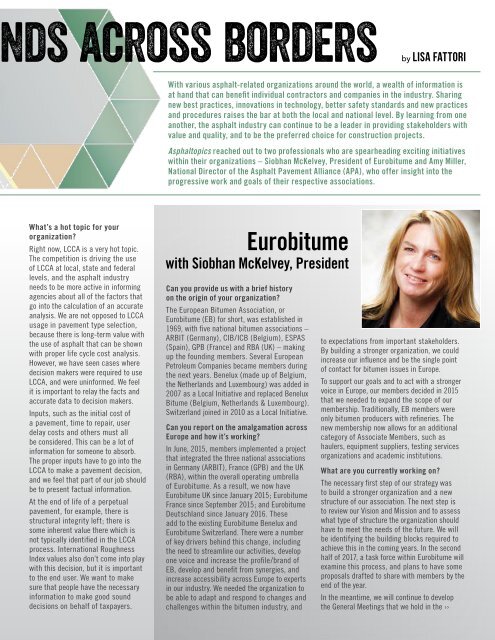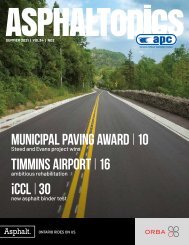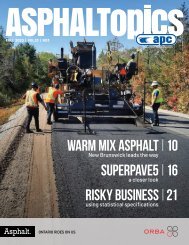ASPHALTopcs | Summer 2017 | VOL 30 | NO 2
You also want an ePaper? Increase the reach of your titles
YUMPU automatically turns print PDFs into web optimized ePapers that Google loves.
ds across borders<br />
by Lisa Fattori<br />
With various asphalt-related organizations around the world, a wealth of information is<br />
at hand that can benefit individual contractors and companies in the industry. Sharing<br />
new best practices, innovations in technology, better safety standards and new practices<br />
and procedures raises the bar at both the local and national level. By learning from one<br />
another, the asphalt industry can continue to be a leader in providing stakeholders with<br />
value and quality, and to be the preferred choice for construction projects.<br />
Asphaltopics reached out to two professionals who are spearheading exciting initiatives<br />
within their organizations – Siobhan McKelvey, President of Eurobitume and Amy Miller,<br />
National Director of the Asphalt Pavement Alliance (APA), who offer insight into the<br />
progressive work and goals of their respective associations.<br />
What’s a hot topic for your<br />
organization?<br />
Right now, LCCA is a very hot topic.<br />
The competition is driving the use<br />
of LCCA at local, state and federal<br />
levels, and the asphalt industry<br />
needs to be more active in informing<br />
agencies about all of the factors that<br />
go into the calculation of an accurate<br />
analysis. We are not opposed to LCCA<br />
usage in pavement type selection,<br />
because there is long-term value with<br />
the use of asphalt that can be shown<br />
with proper life cycle cost analysis.<br />
However, we have seen cases where<br />
decision makers were required to use<br />
LCCA, and were uninformed. We feel<br />
it is important to relay the facts and<br />
accurate data to decision makers.<br />
Inputs, such as the initial cost of<br />
a pavement, time to repair, user<br />
delay costs and others must all<br />
be considered. This can be a lot of<br />
information for someone to absorb.<br />
The proper inputs have to go into the<br />
LCCA to make a pavement decision,<br />
and we feel that part of our job should<br />
be to present factual information.<br />
At the end of life of a perpetual<br />
pavement, for example, there is<br />
structural integrity left; there is<br />
some inherent value there which is<br />
not typically identified in the LCCA<br />
process. International Roughness<br />
Index values also don’t come into play<br />
with this decision, but it is important<br />
to the end user. We want to make<br />
sure that people have the necessary<br />
information to make good sound<br />
decisions on behalf of taxpayers.<br />
Eurobitume<br />
with Siobhan McKelvey, President<br />
Can you provide us with a brief history<br />
on the origin of your organization?<br />
The European Bitumen Association, or<br />
Eurobitume (EB) for short, was established in<br />
1969, with five national bitumen associations –<br />
ARBIT (Germany), CIB/ICB (Belgium), ESPAS<br />
(Spain), GPB (France) and RBA (UK) – making<br />
up the founding members. Several European<br />
Petroleum Companies became members during<br />
the next years. Benelux (made up of Belgium,<br />
the Netherlands and Luxembourg) was added in<br />
2007 as a Local Initiative and replaced Benelux<br />
Bitume (Belgium, Netherlands & Luxembourg).<br />
Switzerland joined in 2010 as a Local Initiative.<br />
Can you report on the amalgamation across<br />
Europe and how it’s working?<br />
In June, 2015, members implemented a project<br />
that integrated the three national associations<br />
in Germany (ARBIT), France (GPB) and the UK<br />
(RBA), within the overall operating umbrella<br />
of Eurobitume. As a result, we now have<br />
Eurobitume UK since January 2015; Eurobitume<br />
France since September 2015; and Eurobitume<br />
Deutschland since January 2016. These<br />
add to the existing Eurobitume Benelux and<br />
Eurobitume Switzerland. There were a number<br />
of key drivers behind this change, including<br />
the need to streamline our activities, develop<br />
one voice and increase the profile/brand of<br />
EB, develop and benefit from synergies, and<br />
increase accessibility across Europe to experts<br />
in our industry. We needed the organization to<br />
be able to adapt and respond to changes and<br />
challenges within the bitumen industry, and<br />
to expectations from important stakeholders.<br />
By building a stronger organization, we could<br />
increase our influence and be the single point<br />
of contact for bitumen issues in Europe.<br />
To support our goals and to act with a stronger<br />
voice in Europe, our members decided in 2015<br />
that we needed to expand the scope of our<br />
membership. Traditionally, EB members were<br />
only bitumen producers with refineries. The<br />
new membership now allows for an additional<br />
category of Associate Members, such as<br />
haulers, equipment suppliers, testing services<br />
organizations and academic institutions.<br />
What are you currently working on?<br />
The necessary first step of our strategy was<br />
to build a stronger organization and a new<br />
structure of our association. The next step is<br />
to review our Vision and Mission and to assess<br />
what type of structure the organization should<br />
have to meet the needs of the future. We will<br />
be identifying the building blocks required to<br />
achieve this in the coming years. In the second<br />
half of <strong>2017</strong>, a task force within Eurobitume will<br />
examine this process, and plans to have some<br />
proposals drafted to share with members by the<br />
end of the year.<br />
In the meantime, we will continue to develop<br />
the General Meetings that we hold in the ››

















